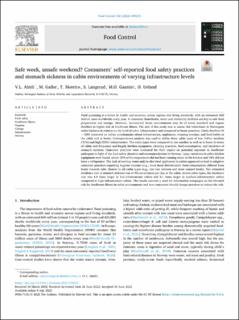| dc.description.abstract | Food poisoning is a threat to health and economy across regions and living standards, with an estimated 600 million cases worldwide every year. In consumer households, water and electricity facilities are key to safe food preparation and storage. However, recreational home environments may be of lower standard and expose dwellers to higher risk of foodborne illness. The aim of this study was to assess risk behaviours in Norwegian cabin kitchens in relation to the level of cabin infrastructure and compared to home practices. Cabin dwellers (N = 339) answered an online questionnaire about infrastructure, appliances, cleaning routines, and food habits at the cabin and at home. Correspondence analysis was used to define three cabin types of low (16%), medium (31%) and high (53%) infrastructure. The cabin types were compared to one another as well as to home in terms of cabin visit frequency and length, kitchen equipment, cleaning practices, food consumption, and incidence of stomach sickness. Consumer practices were evaluated for their impact on potential exposure to foodborne pathogens in light of the food safety situation and recommendations in Norway. Large variations in cabin kitchen equipment were found, where 35% of the respondents did not have running water in the kitchen and 18% did not have a refrigerator. The lack of running water and/or electrical appliances in cabins appeared to lead to adaptive consumer practices regarding hygiene routines (e.g., more hand disinfectant). Food consumption differed from home towards safer choices in all cabin types (e.g., less raw chicken and more canned foods). The estimated incidence rate of stomach sickness was of 4‰ occurrences per day at the cabin. Across cabin types, the incidence rate was 4.0 times larger in low-infrastructure cabins and 3.1 times larger in medium-infrastructure cabins compared to high-infrastructure cabins. The results uncover a need for information campaigns on the elevated risk for foodborne illness in cabin environments and how consumers should change practices to reduce the risk. | |
